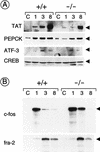Transcription factor CREM coordinates the timing of hepatocyte proliferation in the regenerating liver
- PMID: 9851970
- PMCID: PMC317249
- DOI: 10.1101/gad.12.23.3639
Transcription factor CREM coordinates the timing of hepatocyte proliferation in the regenerating liver
Abstract
The liver regenerates upon partial hepatectomy (PH) as terminally differentiated hepatocytes undergo a tremendous proliferative process. CREM gene expression is powerfully induced during liver regeneration. We show that cell proliferation is significantly reduced upon PH in CREM-/- mice. There is a reduction in DNA synthesis, in the number of mitosis and of phosphorylated histone H3-positive cells. The post-PH proliferation peak is delayed by 10 hr, indicating an altered hepatocyte cell cycle. Expression of cyclins A, B, D1, E, and cdc2, of c-fos and tyrosine aminotransferase is deregulated. CREM mutation results in delayed S-phase entry, impairing the synchronization of proliferation.
Figures







Similar articles
-
Coupling cAMP signaling to transcription in the liver: pivotal role of CREB and CREM.Exp Cell Res. 2002 May 1;275(2):143-54. doi: 10.1006/excr.2002.5491. Exp Cell Res. 2002. PMID: 11969286 Review.
-
Cyclic AMP signalling pathway and cellular proliferation: induction of CREM during liver regeneration.Oncogene. 1997 Apr 3;14(13):1601-6. doi: 10.1038/sj.onc.1200996. Oncogene. 1997. PMID: 9129151
-
Earlier expression of the transcription factor HFH-11B diminishes induction of p21(CIP1/WAF1) levels and accelerates mouse hepatocyte entry into S-phase following carbon tetrachloride liver injury.Hepatology. 2001 Jun;33(6):1404-14. doi: 10.1053/jhep.2001.24666. Hepatology. 2001. PMID: 11391529
-
Rapid hepatocyte nuclear translocation of the Forkhead Box M1B (FoxM1B) transcription factor caused a transient increase in size of regenerating transgenic hepatocytes.Gene Expr. 2003;11(3-4):149-62. doi: 10.3727/000000003108749044. Gene Expr. 2003. PMID: 14686788 Free PMC article.
-
CREM: a master-switch regulating the balance between differentiation and apoptosis in male germ cells.Mol Reprod Dev. 2000 Jun;56(2 Suppl):228-9. doi: 10.1002/(SICI)1098-2795(200006)56:2+<228::AID-MRD2>3.0.CO;2-B. Mol Reprod Dev. 2000. PMID: 10824972 Review.
Cited by
-
Subchronic exposure to TCDD, PeCDF, PCB126, and PCB153: effect on hepatic gene expression.Environ Health Perspect. 2004 Nov;112(16):1636-44. doi: 10.1289/txg.7253. Environ Health Perspect. 2004. PMID: 15598615 Free PMC article.
-
NEDD4 controls the expression of GUCD1, a protein upregulated in proliferating liver cells.Cell Cycle. 2014;13(12):1902-11. doi: 10.4161/cc.28760. Epub 2014 Apr 17. Cell Cycle. 2014. PMID: 24743017 Free PMC article.
-
CREB activation induces adipogenesis in 3T3-L1 cells.Mol Cell Biol. 2000 Feb;20(3):1008-20. doi: 10.1128/MCB.20.3.1008-1020.2000. Mol Cell Biol. 2000. PMID: 10629058 Free PMC article.
-
Mice depleted for Exchange Proteins Directly Activated by cAMP (Epac) exhibit irregular liver regeneration in response to partial hepatectomy.Sci Rep. 2019 Sep 24;9(1):13789. doi: 10.1038/s41598-019-50219-8. Sci Rep. 2019. PMID: 31551444 Free PMC article.
-
Gdnf upregulates c-Fos transcription via the Ras/Erk1/2 pathway to promote mouse spermatogonial stem cell proliferation.Stem Cells. 2008 Jan;26(1):266-78. doi: 10.1634/stemcells.2007-0436. Epub 2007 Oct 25. Stem Cells. 2008. PMID: 17962702 Free PMC article.
References
-
- Albrecht JH, Hoffman JS, Kren BT, Steer CJ. Cyclin and cyclin-dependent kinase 1 mRNA expression in models of regenerating liver and human liver diseases. Am J Physiol. 1993;265:G857–G864. - PubMed
-
- Albrecht JH, Hu MY, Cerra FB. Distinct patterns of cyclin D1 regulation in models of liver regeneration and human liver. Biochem Biophys Res Commun. 1995;209:648–655. - PubMed
-
- Bucher NLR. Regeneration of mammalian liver. Int Rev Cytol. 1963;15:245–300. - PubMed
-
- Cressman DE, Greenbaum LE, De Angelis RA, Ciliberto G, Furth EE, Poli V, Taub R. Liver failure and defective hepatocyte regeneration in interleukin-6-deficient mice. Science. 1996;274:1379–1383. - PubMed
Publication types
MeSH terms
Substances
LinkOut - more resources
Full Text Sources
Other Literature Sources
Molecular Biology Databases
Miscellaneous
